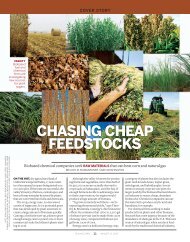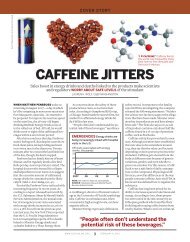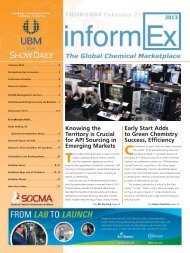Identifying and Evaluating Hazards in Research Laboratories
Identifying and Evaluating Hazards in Research Laboratories
Identifying and Evaluating Hazards in Research Laboratories
Create successful ePaper yourself
Turn your PDF publications into a flip-book with our unique Google optimized e-Paper software.
1. SCOPE AND APPLICATION1.1. ScopeThis guide can be used by an <strong>in</strong>dividual researcher or an <strong>in</strong>stitution <strong>in</strong> the development ofprocesses to effectively <strong>in</strong>tegrate the identification or recognition of hazards <strong>and</strong> the evaluation ofthe risks of those hazards with the aim of us<strong>in</strong>g this <strong>in</strong>formation to formulate a plan to m<strong>in</strong>imize ormanage the risk presented by those hazards prior to the start of work. It also provides strategiesfor: (1) identify<strong>in</strong>g <strong>and</strong> respond<strong>in</strong>g to chang<strong>in</strong>g conditions that can affect a hazard evaluation, (2)implement<strong>in</strong>g processes <strong>in</strong> an <strong>in</strong>stitution not accustomed to the use of the techniques provided <strong>in</strong>this document, <strong>and</strong> (3) assess<strong>in</strong>g implementation of hazards identification <strong>and</strong> evaluationmethodologies.1.2. ApplicationThis guide was written for the researcher without deference to the po<strong>in</strong>t <strong>in</strong> their careers—undergraduate students, graduate students, postdoctoral scholars, <strong>in</strong>structors, pr<strong>in</strong>cipal<strong>in</strong>vestigators (PIs), or department chairs for implementation <strong>in</strong> a scientific research laboratory.Particular consideration was given to the variable nature of research <strong>in</strong> the choice <strong>and</strong> presentationof the techniques provided. Furthermore, recogniz<strong>in</strong>g the variable nature of research, this guideseeks to provide assessment approaches that are relatively easy to implement <strong>and</strong> use. Whileresearch laboratories <strong>and</strong> researchers are the primary audience for this guidance, other audiencesmay f<strong>in</strong>d it equally useful.2. DEFINITIONSChange control: The management process for request<strong>in</strong>g, review<strong>in</strong>g, approv<strong>in</strong>g, <strong>and</strong> carry<strong>in</strong>g out<strong>and</strong> controll<strong>in</strong>g changes to agreed-upon deliverables or operational boundaries. It is sometimesreferred to as "Change Management."Chemical exposure hazard: A chemical for which there is evidence that acute (immediate) orchronic (delayed) health effects may occur <strong>in</strong> an exposed population. Exposure is related to thedose (how much), the duration <strong>and</strong> frequency of exposure (how long <strong>and</strong> how often), <strong>and</strong> the routeof exposure (how <strong>and</strong> where the material gets <strong>in</strong> or on the body), whether through the respiratorytract (<strong>in</strong>halation), the sk<strong>in</strong> (absorption), the digestive tract (<strong>in</strong>gestion), or percutaneous <strong>in</strong>jectionthrough the sk<strong>in</strong> (accidental needle stick). The result<strong>in</strong>g health effects can be transient, persistent,or cumulative; local (at the site of <strong>in</strong>itial contact with the substance), or systemic (after absorption,distribution, <strong>and</strong> possible biotransformation, at a site distant from <strong>in</strong>itial contact with thesubstance).Chemical Safety Levels (CSLs): Def<strong>in</strong>ed levels of hazard (1 through 4):7















